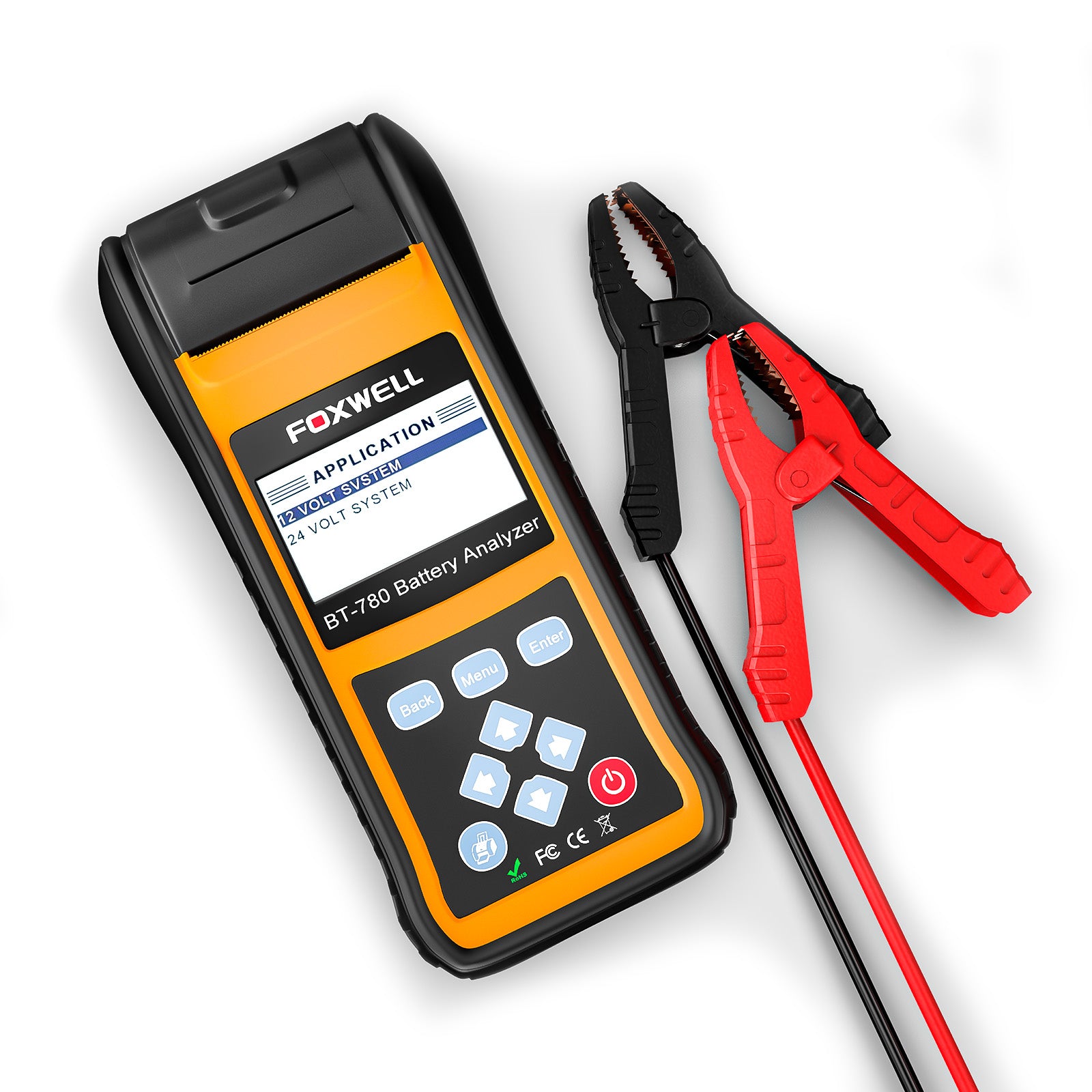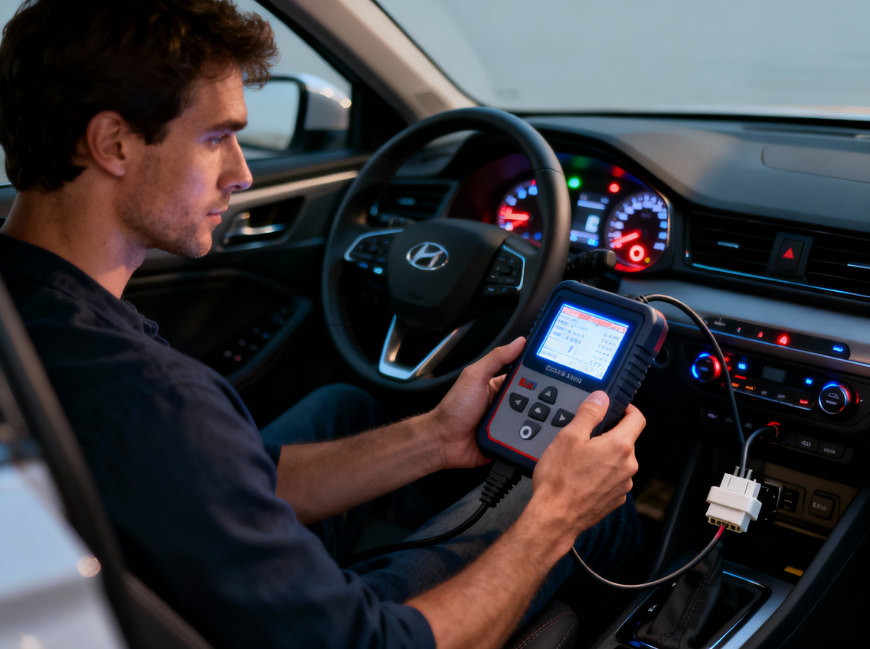What Is the P2138 Code?
The P2138 code is a generic OBD-II/EOBD diagnostic trouble code that stands for “Throttle/Pedal Position Sensor/Switch ‘D’/'E' Voltage Correlation.” P2138 does not indicate a single component failure; rather, it occurs when the vehicle’s ECU detects a mismatch between two critical sensors in the throttle system: the accelerator pedal position (APP) sensor and the throttle position (TPS) sensor.
Specifically, the D and E channel voltage signals from these sensors are inconsistent, causing the ECU to interpret the feedback as unreliable. This can trigger the P2138 fault code and may activate limp mode to protect the vehicle and ensure safety.
On the dashboard or a diagnostic scanner, you may see descriptions such as “P2138 Throttle/Pedal Position Sensor” or “Accelerator Pedal Position Sensor Voltage Correlation.”
How Does the ECU Detect the P2138 Code?
The P2138 code is triggered by the redundancy monitoring mechanism built into the vehicle’s electronic throttle system. Modern vehicles use two primary sensors to manage engine power:
- Accelerator Pedal Position (APP) Sensor – Located under the dashboard and attached to the accelerator pedal, it informs the ECU of how far and how quickly the pedal is being pressed.
- Throttle Position Sensor (TPS) – Mounted on the throttle body in the engine compartment, it provides the ECU with the actual throttle opening angle.
Both sensors are designed with dual signal channels (D and E channels). The ECU continuously compares the voltage values and their variation patterns from these channels.
If the ECU detects a discrepancy between the two signals that exceeds a predefined threshold (for example, a difference greater than 0.5V lasting 2–5 seconds), or if one channel is missing or abnormal while the other is normal, the ECU interprets this as a sensor or circuit fault. It then records and stores the P2138 fault code for diagnostics.
Why Are There Two Channels (D/E)?
Modern vehicles widely adopt Drive-by-Wire (electronic throttle) technology, where the accelerator pedal and throttle body are no longer physically connected by cables. Instead, acceleration commands are transmitted electronically via sensors. For safety, both the APP and TPS sensors are designed with a dual-redundant signal circuit, known as the D and E channels.
These two channels output two independent voltage signals that follow a precise proportional relationship. The ECU continuously cross-checks these signals in real time to verify sensor reliability.
If either sensor’s dual-channel signals become unsynchronized, separated, jump unexpectedly, or fall outside the expected range while pressing the accelerator, the ECU immediately detects a “Voltage Correlation” error and sets the P2138 code.
Why Is the Drive-by-Wire System More Prone to P2138?
The P2138 code is specific to Drive-by-Wire electronic throttle systems and does not occur in traditional mechanical throttle vehicles. Unlike mechanical throttles, electronic throttle systems are highly sensitive and fully rely on the precise signals from the APP/TPS sensors and the ECU software logic.
Any issue in the system—such as synchronization problems, voltage fluctuations, sensor corrosion, wiring looseness, or software errors—can be detected by the redundancy monitoring mechanism, triggering P2138.
This design applies not only to conventional gasoline or diesel vehicles but also to hybrid and electric vehicles (EVs). Understanding the P2138 code is therefore essential for diagnosing modern models from brands like Chevy, GM, Nissan, Subaru, and Harley-Davidson.
Which Vehicle Brands and Models Are Most Susceptible to the P2138 Code?
The P2138 trouble code is not exclusive to any single brand; it is a potential issue for any vehicle equipped with a "Drive-by-Wire" electronic throttle control system. However, due to design specifics, common failure points, or vehicle age, certain brands and models report this code with higher frequency in user communities and repair manuals.
Chevrolet / GM Series
A group particularly prone to P2138, many models under the General Motors umbrella—especially the Chevrolet Cobalt, HHR, Equinox, and Pontiac G5, G6—often have reported cases. The fault may sometimes be specifically logged as DTC P2138:00. Beyond the sensors themselves, a widely documented root cause lies in the wiring system.
In a dedicated owner community for models like the Chevrolet Cobalt and Saturn Sky, owners commonly report being plagued by an intermittent P2138. Initially, owners typically replace both the accelerator pedal assembly and the throttle body, yet the problem often recurs.
The ultimate solution consistently points to a common fix: repairing or replacing the entire wiring harness from the accelerator pedal to the ECU. Due to wire extensions from manufacturing or modifications, the splices in these harnesses can develop resistance over time, interfering with the precise voltage signals. This explains why, in GM vehicles, when sensor replacement fails, inspecting and rewiring the harness becomes the definitive solution to solve this issue.
Nissan
In Nissan models (such as the Altima, Sentra, and Rogue), the P2138 code is often directly related to the accelerator pedal assembly. Owners typically report the vehicle entering limp mode with a delayed response from the accelerator pedal.
Subaru
Subaru owners encountering P2138 generally need to inspect both the accelerator pedal position sensor and the throttle body. Since these vehicles are often driven in varied climates, corrosion of sensor connectors is also a key area to check.
Harley-Davidson
Even motorcycles are not immune, as P2138 is included in the fault code library for some Harley-Davidson models. The diagnostic approach is similar to that for cars, but due to greater vibration, loose or worn wiring harnesses should be a priority inspection point.
Symptoms of the P2138 Code

- Throttle response irregularities
- Activation of Limp Mode
- Engine power limitation
- Unstable idle
- Hesitation during acceleration
- Check Engine Light illuminated
- Abnormal data stream
What Causes the P2138 Code?
- Sensor Malfunction: This is the most common cause. Performance drift, failure, or abnormal signal output from the Accelerator Pedal Position (APP) sensor or Throttle Position Sensor (TPS) can lead the ECU to detect an unreasonable correlation between the signals.
- Wiring and Connector Issues: This cause is very common in practice. Oxidation, loose connections, or poor contact in sensor harness connectors, as well as wiring damage due to wear or high temperatures causing short circuits or open circuits, can interrupt signals or destabilize voltage, preventing the sensors from delivering accurate data to the ECU.
- Mechanical Component Problems: Examples include sticking accelerator pedal mechanisms, worn cables, or unmeasured vacuum leaks in the engine. These issues can interfere with the actual intake air volume, indirectly causing the sensor feedback to mismatch the ECU’s expected values.
- ECU Software or Hardware Malfunction: This is rare. Internal software errors or hardware damage in the Engine Control Unit (ECU) can cause it to misinterpret correct sensor signals, generating erroneous P2138 codes.
- Incomplete Adaptation or Learning Procedures: After replacing the throttle body, ECU, or disconnecting the vehicle battery, failing to properly perform the “Throttle Position Adaptation/Learning” procedure can result in a mismatch between the ECU’s recorded TPS baseline and the APP signals, triggering the P2138 code.
How Serious Is the P2138 Code?
Very Serious. The P2138 trouble code directly affects your vehicle’s power control and driving safety. It is not a simple emissions-related issue, but a serious communication error between core components of the engine management system—the throttle body and the accelerator pedal. Since the Engine Control Unit (ECU) cannot trust these signals, it may take extreme protective measures.
Can You Still Drive with a P2138 Code?
Short-distance, low-speed driving is generally not a major issue—for example, driving from home to a nearby repair shop. However, high-speed or long-distance driving carries risks, such as sudden power loss or lack of throttle response, which can compromise safety.
If the vehicle enters “Limp Mode,” with multiple warning lights on the dashboard, severe shaking, or stalling during driving or shifting, you should stop immediately and seek assistance.
It is strongly recommended that once a P2138 code appears, the throttle body, accelerator pedal sensor, and related wiring should be inspected and repaired promptly.
DIY Methods for Diagnosing the P2138 Code
| Step | Diagnostic Method | Key Actions | DIY Difficulty | Aims to Identify |
|---|---|---|---|---|
| 1 | Initial Visual Inspection | Visually inspect wiring harnesses connected to the Throttle Body and Accelerator Pedal for wear, cuts, or melting (e.g., from the exhaust manifold). Disconnect and reconnect sensor plugs. Check the throttle body for severe carbon buildup. | ★☆☆☆☆ (Low) | Physical wire damage, loose/corroded connectors, mechanical throttle body sticking. |
| 2 | Read Codes & Data Stream |
Use an OBD2 Scanner: 1. Read and confirm the P2138 code. 2. Enter the data stream menu, monitor both APP and TP sensor signals. Slowly press/release the pedal, checking if signals change synchronously and linearly. |
★★☆☆☆ (Medium) | Confirms fault code; reveals sensor signals that are sticky, jumping, non-synchronous, or missing (the key evidence). |
| 3 | Circuit Measurement |
Use a Multimeter to measure at the sensor connector: 1. 5V Reference voltage 2. Ground circuit resistance 3. Signal wire voltage changes smoothly with pedal input. |
★★★☆☆ (Medium-High) | Open/short circuits in wiring, faulty power supply or ground, abnormal sensor output signal. |
DIY Difficulty Legend:
- ★☆☆☆☆ (Low): No special tools needed, safe to perform, suitable for all car owners.
- ★★☆☆☆ (Medium): Requires basic tools (e.g., OBD scanner), requires understanding simple concepts, can be done with care.
- ★★★☆☆ (Medium-High): Requires specialized tools (e.g., multimeter), requires basic circuit knowledge, must be performed cautiously.
When to Seek Professional Help:
- If the code returns promptly after performing cleaning and connector repairs.
- If circuit measurements indicate a missing 5V reference voltage or ground, as the issue may be deeper in the wiring harness or the ECU itself.
- If you feel unsure at any step during the DIY process, stopping and consulting a professional repair shop is the most cost-effective and safe choice. Paying for a short diagnostic session to pinpoint the issue accurately can save you significant time and money wasted on incorrect part replacements.
Diagnosing the P2138 Code with a Professional Tool
The P2138 trouble code involves a mismatch in the Throttle/Pedal Position Sensor (APP) signals, making accurate diagnosis crucial for both DIY users and professional workshops. The Foxwell NT series professional auto scanners, such as the NT710, offer clear advantages in this regard:
- Bi-directional Control: Supports throttle relearn on certain models, improving diagnostic efficiency.
- Freeze Frame Recording: Captures data at the moment the fault occurs for precise voltage difference analysis.
- Extensive Protocol Coverage: Optimized for Chevy, GM, Nissan, and Subaru models, suitable for both DIY users and professional workshops.
About the Foxwell NT710
The NT710 is a fully-featured bi-directional scan tool in the NT series, upgraded from the NT530 Plus and NT510 Elite. It supports full-system diagnostics across ABS, Engine, TPMS, DPF, SRS, Transmission, and more. The tool provides over 30 service reset functions, including oil reset, throttle adaptation, injector programming, and battery registration, and supports ECU coding and bi-directional control operations.
Equipped with a 5.5-inch touch screen, Android operating system, WiFi connectivity, and a 4000mAh battery, the NT710 also offers lifetime free software updates. It is ideal for professional workshops as well as advanced DIY users.
Step 1: Read and Confirm the Trouble Code
Connect a Foxwell NT series or advanced diagnostic tool to read the P2138 code and confirm whether it persists. Clearing the code and reproducing the fault can help determine if the issue is consistently triggered.
Step 2: View Freeze Frame Data
Use the Foxwell tool to access freeze frame data and understand the vehicle’s status at the moment the fault occurred, such as engine RPM, vehicle speed, and throttle angle. This provides a reference for further diagnosis.
Step 3: Monitor Live Data Stream – The Key to Diagnosis
Observe the voltage signals of TPS/APP channels 1 and 2 simultaneously with the Foxwell tool:
- Check if both sensors’ voltages are synchronized and linear during idle and gradual throttle application.
- Watch for voltage overlaps or crossovers that indicate anomalies.
- Compare “normal waveform” with the “P2138 fault waveform” to help users visually understand the fault.
Step 4: Perform Wiring Inspection with a Multimeter
Verify the sensor wiring:
- Check reference voltage, ground, and signal line standard voltages/resistances.
- Ensure the wiring is not damaged, loose, or corroded, to rule out hardware faults.
Why Foxwell NT710 is More Efficient for P2138 Diagnosis
The Foxwell NT710, as a powerful tool in the NT series, offers real-time dual-channel comparison, freeze frame analysis, bi-directional control, and full-system protocol coverage. It is suitable for DIY users to quickly identify issues and meets the precision needs of professional workshops. Combining live data monitoring with wiring inspection allows for accurate fault localization, reducing unnecessary disassembly and repair time.
Related Reading: Foxwell NT710 FAQ: Everything You Want To Know
How to fix P2138 and costs
| Repair Solution | Description | Cost Range |
|---|---|---|
| Clean or Replace Accelerator Pedal Position (APP) Sensor | If the fault is caused by carbon buildup, dust, or minor damage, cleaning can be attempted first. Severely damaged sensors or abnormal signals require replacement. | $80–$250 |
| Replace Throttle Body | Replace when the throttle body is sticking, heavily carboned, or mechanically damaged. | $150–$600 |
| Repair or Replace Wiring/Connectors | Check if APP/TPS sensor wiring is broken, loose, or poorly connected. Damaged wiring can be repaired or replaced. | $20–$150 |
| ECU-Related Operations | For intermittent P2138 faults after warming up, ECU programming or software updates may be required. Some models may also need APP/TPS synchronization (Throttle Relearn) to ensure proper sensor-throttle matching. |
Depends on vehicle and complexity |
How to Prevent P2138 Trouble Code from Recurring
1. Regularly clean the throttle body and APP sensor: Carbon deposits and dust can cause unstable sensor signals. Periodic cleaning helps reduce the likelihood of signal abnormalities. Additionally, it is recommended to have a professional technician inspect and clean the throttle body every 20,000 to 40,000 kilometers. Shorten the cleaning interval if frequently driving in congested conditions.
2. Inspect and maintain wiring and connectors: Regularly check the wiring of the APP and TPS sensors for damage, looseness, or poor contact. Ensure connectors are clean, securely fastened, and protected from moisture or corrosion that could cause signal interference.
3. Use a stable power source and follow proper power disconnect procedures: Periodically check the battery's health. Always turn off all electronic devices and the engine before disconnecting the vehicle's battery for maintenance.
4. Use high-quality parts: When replacement of related components is necessary, prioritize genuine OEM parts or high-quality components from reputable brands.
5. Practice good driving habits: Avoid frequent rapid acceleration and hard braking.
P2138 FAQs
Is P2138 caused by the accelerator pedal or the throttle body?
Both can be the culprit, but the issue is more frequently found on the throttle body side.
The P2138 trouble code indicates that the engine computer (ECU) has detected an implausible correlation between the signal from the Accelerator Pedal Position (APP) sensor and the signal from the Throttle Position (TPS) sensor. In practical cases, a faulty TPS within the throttle body or carbon buildup causing the throttle to stick are the most common causes. Furthermore, problems with the wiring harness or connectors linking these two sensors are also a prevalent issue that can trigger P2138.
Why does P2138 appear more on Chevy vehicles?
This is not a coincidence. On Chevrolet, GMC, Buick, and other GM vehicles, P2138 is a well-known common fault. The main reasons are:
- The electronic throttle system design in these models makes the APP/TPS signal channels highly sensitive.
- Manufacturer protocols require strict voltage consistency between APP channels 1 and 2, so even slight deviations can trigger the code.
- Some Chevy models use sensors or wiring layouts during production that are more susceptible to temperature and vibration, increasing the likelihood of signal drift.
Using a GM-compatible professional diagnostic tool, such as the Foxwell NT710 or NT909, can quickly identify the root cause.
P2138 vs P2135 throttle position sensor codes
How to test accelerator pedal position sensor for P2138
Method 1: Read Real-Time Data with a Professional Diagnostic Tool
Use a diagnostic tool like the Foxwell NT710 to observe whether the APP 1 and APP 2 channel voltages change in a synchronized and linear manner. If the reading from either sensor shows signs of sticking, jumping, returning to zero, or remaining unchanged, or if the voltage values of the two sensors become too close or even cross each other, it indicates a faulty APP sensor.
Method 2: Measure Sensor Voltage with a Multimeter
Refer to the specified voltage values provided in the vehicle's repair manual to check whether the signal wire, reference voltage, and ground circuit are functioning normally.
Method 3: Wiring and Connector Inspection
Check the sensor plug and wiring harness for loose connections, broken wires, or poor contact.
Related Codes
P0456: Evaporative Emission Control System Leak Detected (Very Small Leak)
P0455: Evaporative Emission Control System Leak Detected (Large Leak)
P2228: Barometric Pressure Sensor 'A' Circuit Range/Performance
Real-World Case: Lexus IS300 P2138 Troubleshooting Experience
A Lexus IS300 owner documented their experience with P2138, where the vehicle exhibited poor acceleration and entered Limp Mode. The owner initially performed routine maintenance such as cleaning the throttle body and MAF sensor and replacing the spark plugs, but the issue persisted.
Further investigation revealed that the root cause was the throttle body wiring not properly reconnected, combined with aging wiring harnesses that caused D/E voltage channel inconsistencies.
This case demonstrates that P2138 does not necessarily indicate a faulty accelerator pedal or throttle body sensor. Wiring issues—particularly worn, loose, or heat-affected connections—can often lead to voltage discrepancies that trigger P2138.
Source: Reddit user experiences (u/Jeep, u/claimedbyshadow)







Leave a comment
This site is protected by hCaptcha and the hCaptcha Privacy Policy and Terms of Service apply.